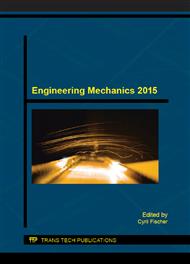[1]
Holicky, M., Sykora, M. & Retief, J.V., General Approach to Model Uncertainties. Proc. 12th Int. Probab. Workshop IPW 2014, Bauhaus-Universitätsverlag: Weimar, pp.311-321, (2014).
Google Scholar
[2]
Sykora, M., Holicky, M., Prieto, M. & Tanner, P., Uncertainties in resistance models for sound and corrosion-damaged RC structures according to EN 1992-1-1. Materials and Structures, DOI: 10. 1617/s11527-014-0409-1, (2014).
DOI: 10.1617/s11527-014-0409-1
Google Scholar
[3]
Holicky, M., Sykora, M. & Retief, J.V., Assessment of Model Uncertainties for Structural Resistance (accepted for publication). Probabilistic Engineering Mechanics, (2015).
Google Scholar
[4]
JCSS, JCSS Probabilistic Model Code, Joint Committee on Structural Safety: (2001).
Google Scholar
[5]
EN 1993-1-1. Design of steel structures – Part 1-1: General rules and rules for buldings. December (2006).
Google Scholar
[6]
Rondal, J. & Rasmussen, K.J.R., On the strength of cast iron columns. Journal of Constructional Steel Research, 60(9), pp.1257-1270, (2004).
DOI: 10.1016/j.jcsr.2003.12.006
Google Scholar
[7]
Ramberg, W. & Osgood, W.R., Description of stress-strain curves by three parameters (report No. NACA-TN-902), National Advisory Committee for Aeronautics: Washington, DC, United States, p.29, (1943).
Google Scholar
[8]
Salmon, E., Columns (thesis), Oxford Technical Publications: Oxford, (1921).
Google Scholar
[9]
Nadolski, V. & Sykora, M., Uncertainty in Resistance Models for Steel Members. Transactions of the VSB - Technical University of Ostrava, Civil Engineering Series, 14(2), pp.26-37, (2014).
DOI: 10.2478/tvsb-2014-0028
Google Scholar
[10]
Nadolski, V. & Sykora, M., Model Uncertainties in Resistances of Steel Members (accepted for publication). Proc. ESREL 2015, Taylor and Francis/ Balkema: Leiden, (2015).
DOI: 10.1201/b19094-548
Google Scholar
[11]
Sykora, M., Holicky, M. & Markova, J., Verification of existing reinforced concrete bridges using the semi-probabilistic approach. Engineering Structures, 56(0), pp.1419-1426, (2013).
DOI: 10.1016/j.engstruct.2013.07.015
Google Scholar
[12]
Caspeele, R., Sykora, M., Allaix, D.L. & Steenbergen, R., The Design Value Method and Adjusted Partial Factor Approach for Existing Structures. Structural Engineering International, 23(4), pp.386-393, (2013).
DOI: 10.2749/101686613x13627347100194
Google Scholar
[13]
Heyde, S. & Lindner, J., Investigations on historic grey cast-iron columns. Proc. EUROSTEEL 2008, eds. R. Ofner, D. Beg, J. Fink, R. Greiner & H. Unterweger, ECCS Southampton: Brussels, pp.1545-1550, (2008).
Google Scholar


